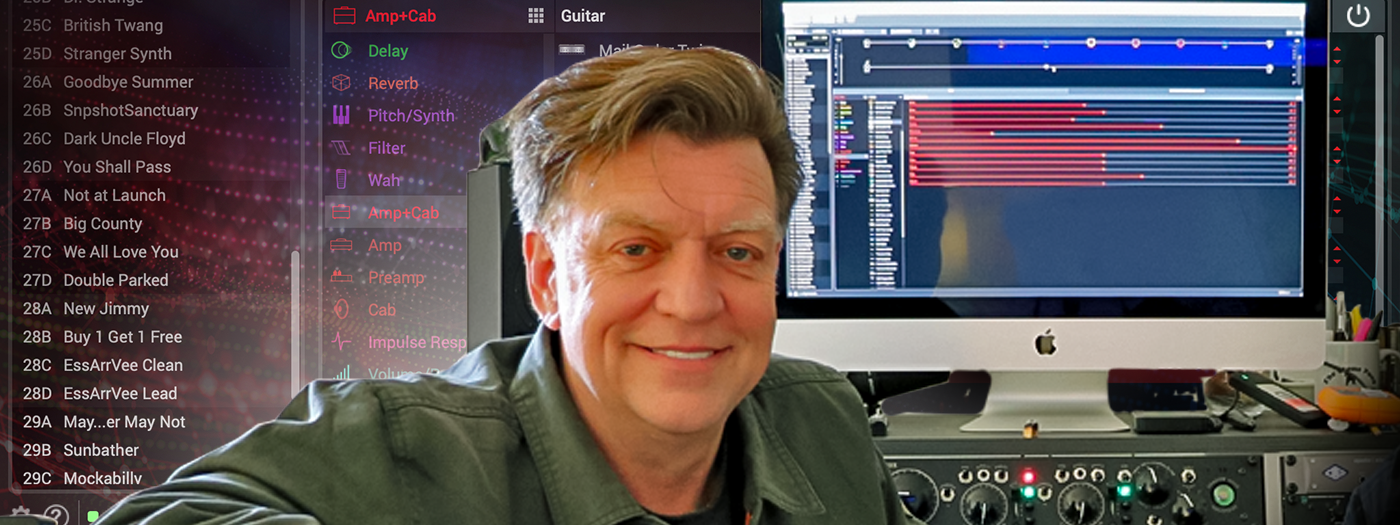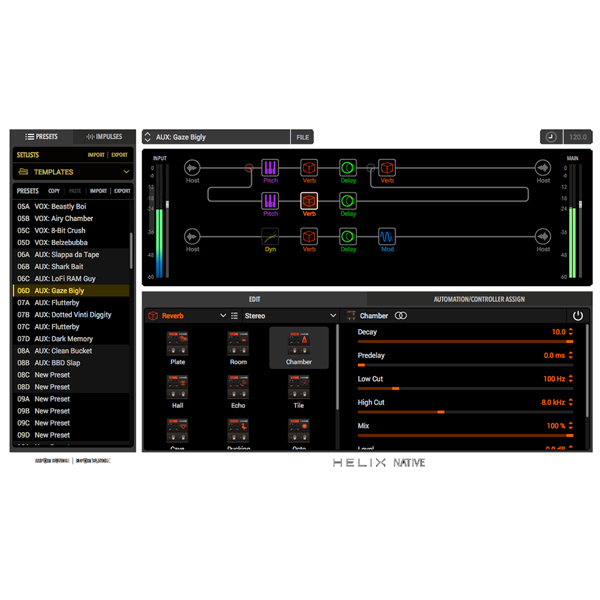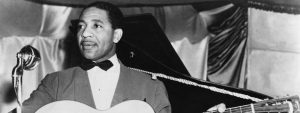Dan Boul: My Helix Native Lockdown Revelation
by Dan Boul
Home recording has been a side pursuit and passion of mine for many years, but I had always found it difficult to record truly great guitar sounds outside of professional studios. I could get acceptable sounds, but they were never as good, even after spending more than $10,000 on microphones, preamplifiers, and other gear. And because of the setup time and other effort required, I would often become apathetic about doing it at all. It was just easier to book time in a local studio.
Then came 2020 and even what I had been doing would no longer work. The pandemic, the lockdown, kids at home 24/7, etc. How on earth was I supposed to record guitars? I couldn’t make any noise without ruining my wife’s home office experience and my kids’ online school experience.
Enter the Helix Native plugin.
As many of you know, I’ve been consulting at Line 6 for the past four years and I have had a lot of fun learning the new paradigm of the digital guitar amp world. Much of my time has been focused on the Helix amp and effects processor and creating impulse responses (IRs) to help widen its vocabulary—but I hadn’t really spent much time with Helix Native plugin. That was a mistake!
I have always been fascinated by people who are proficient at recording amazing guitar sounds. Through my amp company and my previous life in the music business, I’ve had the great good fortune to sit in control rooms with some of the top producers and engineers on the planet. Through osmosis—and asking a lot of dumb questions—I’ve learned quite a bit about recording guitars. I’m above average, but not an expert. Helix Native is a powerful recording tool that has enabled me to appear to be a much better engineer than I actually am, by getting amazing guitar sounds in my home studio that I previously never imagined were possible.
After having that realization, I took the plugin to some top-level recording engineers and asked them if the guitar recording techniques they used in the physical world would translate to the digital domain of Helix Native. As you might imagine, most of the industry professionals that I brought this up with were very skeptical and it took multiple attempts to get them to even listen to the plugin. Ultimately, though, the results and responses were entirely positive.
One premier producer in particular that I’ve known for decades had a lot of fun teasing me about “switching teams” and “heading to the dark side” by embracing digital modeling technology. Time after time, I’d get hilarious comments poking fun at me and zero interest in even hearing the sounds. Last year, however, he walked in during a session in Hollywood and said, “That sounds great! What is it?” I replied, “That stuff you’ve been teasing me about for a while now!” From that point on he was, and remains, hooked. After a few demonstrations, he and several others like him now see the immense value in being able to use their professional production skills to quickly and easily craft proper guitar sounds in even the smallest rooms and without making a lot of noise. Songwriting, demo, and collaboration processes are all easily streamlined and significantly improved.
What makes using Helix Native a great alternative to conventional home recording? For one thing, in addition to the many amplifier and cab models available, you can load third-party IRs. These are often created by professional engineers using one or more high-end microphones, mic preamps, and other gear that is unobtainable for ordinary humans, and would cost tens of thousands of dollars to acquire in the real world. Plus, when they are correctly made, IRs don’t suffer from phase and other technical issues, which is a giant advantage for home recordists and even amateurs just having fun.
Besides the sonic advantages, there are lots of recording processes that are simply faster and easier to accomplish in the virtual world than with hardware. For instance, when doubling a guitar track, you could obviously load a different amp to get a complementary tone on the doubled track—but you could also keep the same amp and load a different IR to get alternative cab, mic, and room setups. Then, you could copy both of those tracks and swap out entirely different cabs with different mics and rooms on two of them. Suddenly, you’ve got doubled guitars stacked in pairs, with a variety of different textures and tones, perfectly done in a tiny fraction of the time it would take you to do it physically. Not bad, huh?
In addition to using the same techniques you’d use in the analog world, you can do a lot of things that would be difficult or even impossible outside of the digital domain. A great example of this is running a 100-watt Plexi head into a mid-’60s Deluxe speaker IR, which is one of my favorite combinations. Of course, you’d never dream of doing this in the real world because of the instant destruction of a great old Jensen speaker, but it sounds fantastic. Another setup I use frequently is an AC30 head in parallel with a blackface Deluxe running through two old Marshall cab IRs and a Jensen IR, which is insanely textured and rich sounding. And if I’m feeling extra creative, I might swap out the virtual microphones and preamps by using variations on the IRs. This setup would be ridiculous in the studio, and the phasing issues alone would take a long time to sort out—but in Helix Native, it’s nearly instantaneous!
Learn more about Helix Native: https://line6.com/helix/helixnative.html

Dan Boul is a Los Angeles-based guitarist, engineer, producer, amp designer, and consultant, as well as a co-founder of the premium boutique amplifier company 65amps.
Related posts
Leave a Reply
You must be logged in to post a comment.
By submitting your details you are giving Yamaha Guitar Group informed consent to send you a video series on the Line 6 HX Stomp. We will only send you relevant information. We will never sell your information to any third parties. You can, of course, unsubscribe at any time. View our full privacy policy






Hi Dan,
Thanks for this post. I am going to be honest. I kinda still am in the first camp you mentioned. I can never get virtual sound to sound as good as analog recorded guitars. The Vox/Blackface combo you mentioned sounds super nice to me. Would you be willing to share a little bit more about how you set that up? Thanks again, Zack
OK Line 6 the secret is out. You found our local treasure here in Los Angeles, Dan Boul. Congrats on featuring him on your channel. Dan is a wealth of knowledge for us guitar players and does it effortlessly with his feet-on-the-ground mid-west approach. I’d love to see more in-depth features on him and how he sets up his DAW, IRs and Line 6 Helix.
Dan
Your article reads just like one of our numerous sit-downs, of which in this case again, I completely agree with.
Iv’e been using HX Stomp as a stand alone guitar interface into my UA/Luna system and it’s been the game changer.
I haven’t mic’d an amp in months, even my own builds. Now that I’ve read this article I am going to investigate the Helix
Native world much deeper. Seeing how we’ve both been romanced unto the Dark Side of Digital, the bonus is we all
have something to show for it… in Triplicate SQUARED!
Thank you for being Dan.
Billy Yates
Guitarist-Engineer-Producer
Friend of Dan Boul
Dan,
So cool to hear from your experienced perspective! Would love the opportunity to experience some of your favorite sounds–like the one that turned the head and heart of the doubtful producer you mentioned in the article. 🙂 Would you be willing to share some of your favorite helix patches with the community? I, for one, would be sincerely grateful for the learning opportunity to see, hear, and experience guitar tone from your perspective, all of which is something the helix patches can help facilitate. Thank you in advance for your consideration!
Thanks guys! I really appreciate the kind words and this software has sincerely been a blast to get intimate with! And yes, I’ll share some patches, presets, and tracks next week; my pleasure. There’s a few standard procedures that I use on almost every patch that makes it feel more natural and encouraging similar to nice tube amp. This makes the entire paradigm feel much more friendly and useable which allows me to focus on my playing instead of learning to work within the confines of the particular setting. More to come and thanks again!!